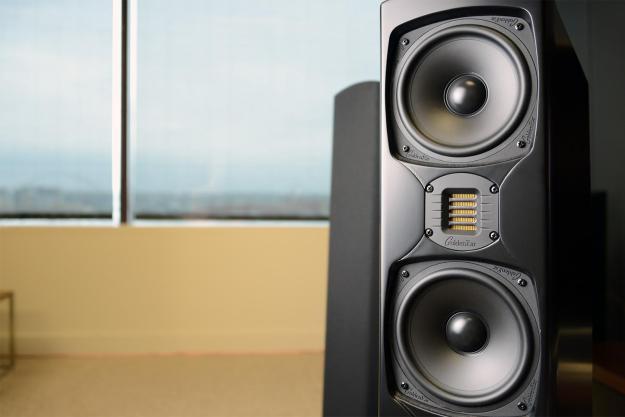
“We put the Triton Five in the ring with a speaker costing 15 times as much, and it danced out with a sonic TKO.”
- Wide soundstage, pinpoint imaging
- Gorgeous, detailed treble
- Wide-open, transparent midrange
- Outstanding transient response
- Less bass than we expected
- Black monolith style not for everyone
- Sensitive to room placement
GoldenEar Technology’s speakers have received universal acclaim from professional audio reviewers for consistently delivering performance that meets or exceeds that of speakers costing several times more. The accolades are so profuse that I wouldn’t blame someone on the outside looking in for wondering if GoldenEar packs some sort of aerosolized aphrodisiac with their wares that causes reviewers to fall into a deep state of questionably appropriate lust with these inanimate objects.
I’m here to assure you nobody is getting slipped a mickey — the speakers are just that good. But I, like many others, often wonder at how good our sonic memories can really be. Is it really fair (or wise) to compare a speaker to something much more expensive that we once heard months, years, or even decades ago? Wouldn’t it be fun (and revealing) to conduct a side-by-side shootout between a GoldenEar speaker and one that costs 15 times as much, with all other variables equalized?
Well, as luck would have it, I finally got that chance.
The contenders
In the red corner, standing 49.5-inches tall, weighing a combined 320 lbs., armed with four 6.5-inch mid/woofers and a 6.5-inch coaxial midrange/tweeter in each vented enclosure roughly the size of a small piano, ladies and gentleman, puts your hands together for the $30,000-a-pair luxury titan, the Technics Reference Class R-1!
- 1. Technics Reference Class R-1
- 2. GoldenEar Technology Triton Five
And in the blue corner, standing 44.25 inches tall, weighing a combined 80 lbs, armed with two 6-inch mid/woofers coupled to four 8-inch passive radiators and a high-velocity folded ribbon tweeter in each svelte, sock-wrapped enclosure, give it up for the $2,000-a-pair sonic underdog, the GoldenEar Technology Triton Five!
Let’s rumble.
The ring
To continue our boxing metaphor (or UFC, if you prefer), let me describe for you the ring in which these two speaker systems will duke it out.
Round 1 starts things off with Technics’ Reference Class electronics in play, including the SU-R1 Network Audio Control Player (basically a network-connected preamp and processor) and the 119 lb., 300-watt per channel (into 4 ohms) SE-R1 power amplifier. For Round 2 we’ll scale things down and alternate between two integrated amplifiers, the Anthem Integrated 225, and the Peachtree Audio Nova 220SE, each running upwards of 220-watts per channel. Finally, for Round 3, we bring in the Mighty-Mouse of the bunch, the PS Audio Sprout, sporting about 50 watts per channel of digital amplification.
Sources in all three rounds include vinyl played back through a U-Turn Audio’s Orbit turntable matched with the company’s PLUTO phono pre-amp, disc-based music delivered from Pioneer’s BDP-88FD universal disc player, high-res audio delivered via USB flash drive, and streaming music from Spotify and Apple Music delivered via PC USB.
Ready? Fight!
Round 1
When paired with its Reference-Class constituents, the Technics R-1 speakers are a sonic force to be reckoned with. Many a DT staffer has entered our sound room with the intention of spending a few minutes auditioning a couple of cuts only to lose themselves for – no exaggeration here – hours at a time. The R-1 produce a wholly satisfying sound, with a soundstage that is as deep as it is wide, and imaging properties that tread onto electrostatic speaker turf, but with the sort of deep, high-impact bass response most folks are forced to source from a subwoofer. Oh, and the dynamics? Incredible. Indeed, under the best conditions, the R-1 is a revelation to even the most novice listeners.
The Triton Five painted a life-like musical portrait almost as large in size and scope as the speakers costing 15 times as much.
With the bar set so incredibly high, we were pretty sure a quick switch the GoldenEar speakers was going to be a shocking disappointment to the auditory senses. Indeed, we were shocked, but not with disappointment … not at all. We raised our eyebrows in disbelief as the Triton Five painted a life-like musical portrait almost as large in size and scope as the speakers costing 15 times as much.
Certainly, the massive Technics R-1 had a big advantage in the bass and mid-bass department, the soundstage had more depth and breadth, and the dynamics swings were much more dramatic, but when it came to pure midrange and treble production, the Triton Five stood right up and proved that they had more than enough fortitude to make the cost-no-object speakers seem silly by comparison.
To be clear, the R-1 did sound better in this scenario. But did they sound $38,000 better than the Triton Five? Hell no.
We’ve got to call Round 1 for Technics because the synergy among the components in the full Reference Class system really is a marvel to behold. But once we strip away those premium electronics, things get to changing very quickly.
Round 2
After auditioning both the Technics R-1 and the Triton Five on the massive Technics amplifier, it became clear that while the R-1 speakers were guzzling current from the Technics amp’s teat, the Triton Five were simply sipping.
Now, with slightly more modest amplification coming from the aforementioned Anthem and Peachtree integrated amps, the Technics R-1 sounded somehow less spectacular, while the Triton Five sounded just as majestic as they had before. In fact, the Peachtree Nova 220SE once again proved it is a particularly synergistic pairing for the Triton Five, ever so slightly smoothing out any harsh edges of treble-intensive instruments without forfeiting any transient detail. The Triton Five’s tweeter, once again, became the star of the show, providing gritty textures and vibrant sympathetic harmonies from all manner of acoustic instruments. And when it came time to rock, the Fives were able to get loud without compressing the signal, providing a lifelike reproduction of one distorted guitar solo after another without threatening listener fatigue.
Round two goes to the Triton Five.
Round 3
This portion of our evaluation was really just for kicks. A 50-watt-per-channel amp no larger than a hard-cover book driving two pair of high-quality tower speakers? Come on! How could we not? But it turned out to be a much more revealing test than we had anticipated.
Simply put, the Triton Five is a delight for the ears.
The Sprout is not a gutsy amp by any means — it’s meant for low-to-moderate listening levels. But its utility makes it highly appealing. With on-board Bluetooth, a quality phono pre-amp, and a great headphone amp built right in, the Sprout makes an awesome centerpiece for a simple, personal listening station. But, as we learned, it can do an admirable of job powering a pair of reasonably easy-to-drive towers to respectable listening levels, while keeping itself together in the process.
Due to their lower impedance, the Technics R-1 are not a good match for something like the Sprout, but the Triton Five sounded surprisingly well-supported in this configuration. For anyone with more room for speakers than electronics and no need to wall-splitting sound pressure levels, we’d even go so far as to recommend the pairing.
And the winner is …
Look, the Technics system is a $60,000 trophy – an absolutely incredible-sounding trophy to be sure, but a trophy none-the-less, and one that we’d wager to guess most of our readers couldn’t afford, nor would they choose to purchase, even if they could afford it.
The GoldenEar Triton Five, on the other hand, are reasonably attainable for nearly anyone willing to save up a few bucks, and they deliver outstanding sound quality for the price, making them the clear winner in this unlikely matchup.
I do, however, have one caveat to add to this otherwise glowing GoldenEar speaker review: I wish the Triton Five put out a little more bass. When I look at the Five, its size preps an expectation within me for a certain amount of bass, but doesn’t quite deliver. Look, the bass will be ample in its quantity for many, and the quality is outstanding by any measure. It’s just … I want more, that’s all there is to it. Perhaps I’m asking too much of four 6-inch midbass drivers and 8-inch passive radiators, but my experience tells me otherwise. Of course, for that sort of sound, there’s always the Triton One, or perhaps the addition of an SVS SB2000 subwoofer to round things out (GoldenEar also makes fine subs, I’ve just never reviewed one). You’ll just need to up the budget a pinch.
Conclusion
The DT Accessory Pack
Up your game and the get the most out of your gear with the following extras, hand-picked by our editors:
Peachtree Audio nova220SE Integrated Amplifier ($1,600)
Kimber Kable 4PR Speaker Cable ($137)
SVS SB2000 Subwoofer ($700)
Track after track, we delighted in the Fives’ ability to deliver superbly life-like sound. Vocals, especially, sounded remarkably genuine, and wind instruments came across with the overtones and presence most folks only get to experience at live performances. Instrumental spacing, soundstage, and imaging are all excellent with this speaker. Simply put, the Triton Five is a delight for the ears, and it’s a speaker that will pair well with myriad modest electronics and still sound superb, leaving you free to spend the big bucks on life’s, shall we say, more essential items. You know, like a car, or a down payment on a house.
Highs
- Wide soundstage, pinpoint imaging
- Gorgeous, detailed treble
- Wide-open, transparent midrange
- Outstanding transient response
Lows
- Less bass than we expected
- Black monolith style not for everyone
- Sensitive to room placement











